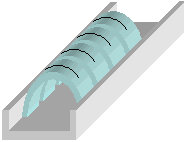- Universal testing machine
- Fixtures
- Biomedical device/equipment
- Vehicles (car, motorcycle)
- Compression/Flexural test
- Hardness tester
- Impact testing machine
- Torsion testing machine
- Abrasion & wear tester
- Plastic & Pipe testing
- Tensiometer / Goniometer
- Erichsen cupping tester
- Other Testing Equipment
- Grinding & polishing machine
- Introduction
- Specification
- Accessories
- Standard
- LEAFLET & VIDEO
- Contact Us
ESC-95 Environmental Stress Cracking Resistance (ESCR) Apparatus determines the susceptibility of ethylene plastics to stress-cracking when exposed to different environments such as soaps, wetting agents, oils and detergents. When the material is under certain conditions of stress, these reagents can accelerate the cracking process which is one of the most common causes of unexpected brittle failure of polymers known. Designed in accordance with the ISO 4599, ASTM D1693 international test standard, the apparatus is extremely cost effective and very simple to use.
Feature:
1, Manufactured to a high standard, the apparatus is supplied with electronic digital temperature control, temperature bath and all tooling accessories.
2, The integrated temperature bath fitted with digital temperature controller, heater and a PT100 platinum resistance thermometer accurately maintains the test temperature, accuracy is ± 0.5 °C.
3, To ensure temperature stability within the bath, a stirrer motor system is fitted and the built in electronic timer monitors the duration of the test.
4, The bath is fitted with a stainless steel sample rack which holds up to 8 glass test tubes which are immersed in a heat transfer medium such as silicone oil.
5, The specimen holder is designed to maintain a constant stress on the mid section of the test samples with up to 8 specimens fitted into a specimen holder at one time.
Main application:
Plastic material, cable industry
Test Procedure:
Environmental stress cracking is the formation of cracks in a material caused by relatively low tensile stress and environmental conditions. Environmental Stress-Cracking Resistance (ESCR) is the number of hours that 50% of the specimens tested exhibit stress cracks.
? ESCR Specimen
ESCR Specimen  ESCR Specimens in Holder
ESCR Specimens in Holder
ESCR testing is performed by slowly bending the test specimens and placing them in a holding clamp. The clamp and specimens are then placed in a test tube and immersed in a specified reagent. The test tube is sealed and placed in a constant-temperature bath. Multiple test specimens are tested at one time.
Specimens are inspected periodically for failure. Cracks generally develop at the notch, perpendicular to the notch, and run to the edge of the specimen. Any cracks constitute failure, not just cracks that reach the edge of the specimen. Cracks sometimes appear beneath the surface and are visible as surface depressions. If a depression develops into a surface crack the time at which the depression was noted is taken as the time of failure.
| Model | ESC-95 |
| Bath temperature range | ambient temperature to 95℃ |
| Temperature accuracy | ± 0.5℃ |
| Sample dimensions | Length: 38±2.5mm, Width: 13±0.8mm, Height: 1.75--3.00 mm |
| Heating power | 3Kw |
| Volume | 40L |
| Power supply | 220V, 50HZ, 1 phase |
| Sample cutting device notch depth | 0.3~0.65 mm |
| Weight | 30Kg |
| Item | Quantity |
| Frame | 1 set |
| Test tube rack | 1 set |
| Notch jig | 1 pc |
| Blanking die | 2 pcs |
| Test tube | 1 pc |
| Sample moving pliers | 1 pc |
| Sample bending device | 1 pc |
| Blade | 1 pc |
| Documents (Manual, packing list, certificate) | |
ISO 4599 "Plastics -- Determination of resistance to environmental stress cracking (ESC) -- Bent strip method”
ASTM D1693 "Standard Test Method for Environmental Stress-Cracking of Ethylene Plastics“
GB/T 1842 etc.
 Global links
Global links

